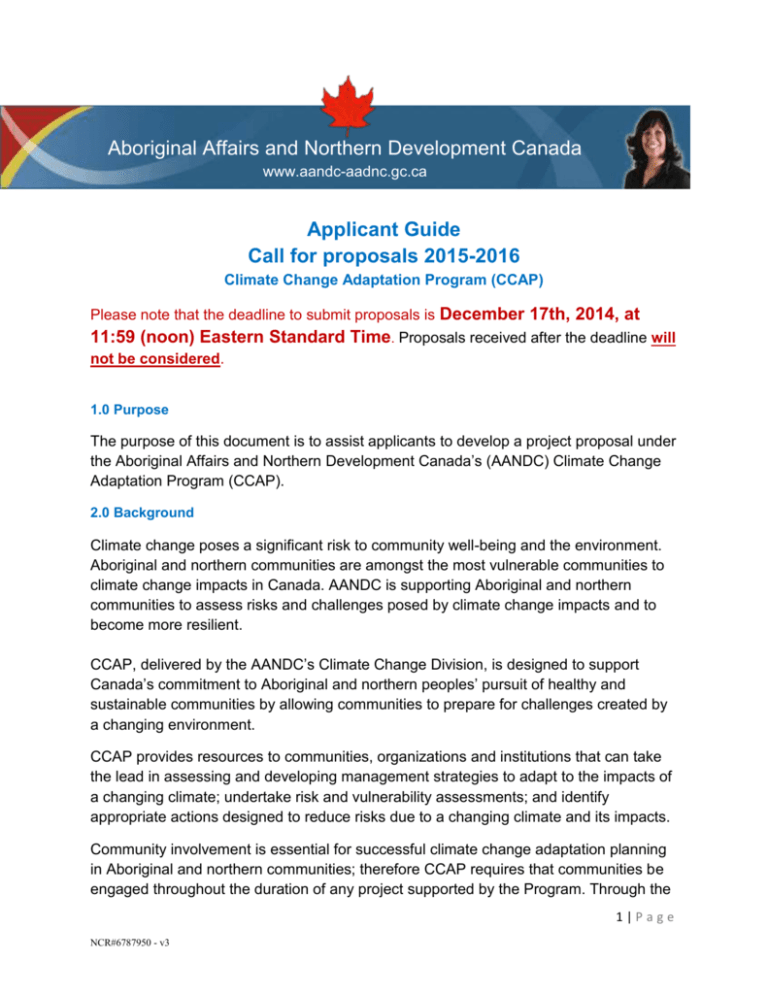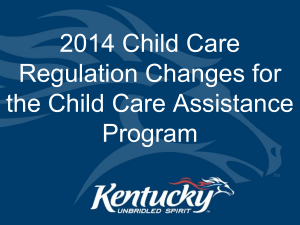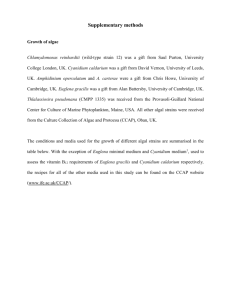4.2 Stream A – Projects Located in the North
advertisement

Aboriginal Affairs and Northern Development Canada www.aandc-aadnc.gc.ca www.aandc-aadnc.gc.ca Applicant Guide Call for proposals 2015-2016 Climate Change Adaptation Program (CCAP) Please note that the deadline to submit proposals is December 17th, 2014, at 11:59 (noon) Eastern Standard Time. Proposals received after the deadline will not be considered. 1.0 Purpose The purpose of this document is to assist applicants to develop a project proposal under the Aboriginal Affairs and Northern Development Canada’s (AANDC) Climate Change Adaptation Program (CCAP). 2.0 Background Climate change poses a significant risk to community well-being and the environment. Aboriginal and northern communities are amongst the most vulnerable communities to climate change impacts in Canada. AANDC is supporting Aboriginal and northern communities to assess risks and challenges posed by climate change impacts and to become more resilient. CCAP, delivered by the AANDC’s Climate Change Division, is designed to support Canada’s commitment to Aboriginal and northern peoples’ pursuit of healthy and sustainable communities by allowing communities to prepare for challenges created by a changing environment. CCAP provides resources to communities, organizations and institutions that can take the lead in assessing and developing management strategies to adapt to the impacts of a changing climate; undertake risk and vulnerability assessments; and identify appropriate actions designed to reduce risks due to a changing climate and its impacts. Community involvement is essential for successful climate change adaptation planning in Aboriginal and northern communities; therefore CCAP requires that communities be engaged throughout the duration of any project supported by the Program. Through the 1|Page NCR#6787950 - v3 leadership of key community members, Aboriginal and northern communities can plan and adapt to climate change. 3.0 Funding available under CCAP in 2015-2016 CCAP will be funding projects through two streams. Stream A will target projects that are in the north and Stream B will focus on projects in the south. The amount of funding available for 2015-2016 under AANDC’s Climate Change Adaptation Program is $2.25M. Funding allocation will be based on the merit of the proposal; however, the priority for 2015-2016 funding may be given to non-completed multi-year projects. A number of currently funded CCAP projects are multi-year projects and a proportion of them will be in their final stage in 2015-2016. In order to ensure that all projects are completed, the priority may be given to these projects. The program ends in March 2016 and for this reason, new funding applications must complete their project by March 31st, 2016. 4.0 Program Objectives Each project proposal must address one or more of the following: Community vulnerability assessment: identification of vulnerability, risk and/or opportunities related to climate change impacts. Community adaptation planning: development of adaptation plans and integration of adaptation into community plans/decision-making processes. 4.1 Program Criteria To be eligible, project proposals must meet ALL of the following criteria: demonstrates a clear link to climate change impacts and adaptation; the applicant is eligible; the objectives of the project are consistent with program objectives; the proposal addresses one or more of the priority areas; the methodology demonstrates how the proponent will address the objectives of the project; and, the project is community driven and includes a capacity building component. Examples of projects / activities that are NOT eligible to the program are projects focussing on: 2|Page NCR#6787950 - v3 environmental monitoring food security emergency management/preparedness development of school curriculum health related studies inventory of species and/or ecological assessment renewable energy and/or energy efficiency projects1 implementation of adaptation measures general climate change outreach and knowledge transfer 4.2 Stream A – Projects Located in the North The northern region encompasses Yukon, Northwest Territories, Nunavut, Nunavik, and Nunatsiavut. Eligible funding recipients include: First Nations and Inuit or their organizations such as boards, committees, agencies, band operated enterprises or other entities as designated by the Chief and Council, Tribal Councils or Hamlet; Individuals; Organizations (e.g., associations, not-for-profit institutions, education/research institutions, etc); and Other levels of government and other non-federal entities, public or private. 4.2.1 Priority Areas Each proposal for projects located in the north must address one or more of the following priority areas in the context of climate change adaptation: infrastructure vulnerability permafrost degradation coastal erosion, sea level rise and sea ice dynamics drinking water quality and availability / waste water management extreme weather events (e.g., flooding , forest fires, storms, etc.) winter roads Please consult Section 4.6 for definitions of priority areas. 4.3 Stream B – Projects Located in the South The southern region encompasses all ten (10) provinces (excluding Nunavik and Nunatsiavut). Eligible recipients for funding include: First Nation communities, which includes: 1 Please consult http://www.aadnc-aandc.gc.ca/eng/1100100034258/1100100034259 for additional information on AANDS’s ecoENERGY program and funding opportunities. 3|Page NCR#6787950 - v3 a First Nation government in a province, including a band or tribal council or its agent (including its wholly owned corporation), on the condition that the First Nation has indicated support for the project and for the legally designated representative to act as an Applicant through a formal band or tribal council resolution; and Innu communities where the applicant is on reserve or on Crown Land in the provinces. But does NOT include (in the provinces): Departments, ministries and agencies of Canada or of a Province or Territory and federal, provincial departmental corporations or Crown corporations. Any other entity that delivers core municipal services. Non-governmental organizations, not-for-profit organizations, consulting firms, academic and research institutions, private sector, etc. 4.3.1 Priority Areas Each proposal for projects located in the south must address one or more of the following priority areas in the context of climate change adaptation: infrastructure vulnerability coastal erosion, sea level rise and sea ice dynamics drinking water quality and availability / waste water management extreme weather events (e.g., flooding, forest fires, storms, etc.) winter roads hazard mapping Please consult Section 4.6 for definitions of priority areas. 4.4 Eligible expenses Examples of eligible project expenses includes salaries and wages, transportation, accommodations and living allowance, training and workshops, professional services (to a maximum of 40% of CCAP contribution), audit (to a maximum of 5% of CCAP contribution), communications, office supplies and equipment dedicated to the project, printing, data collection, analysis and reporting, and administrative costs (to a maximum of 15% of CCAP contribution). 4.5 Maximum amount allowed per project per year Funding can be provided to a maximum amount of $200,000. 4.6 Priority Areas Definitions For the purpose of the 2015-2016 CCAP program at AANDC, projects will need to address the following aspects in the context of climate change: 4|Page NCR#6787950 - v3 Infrastructure Vulnerability: Infrastructure is defined as a physical structural element needed for the operation of a community. Such items include but are not limited to: community buildings (schools, community centers, band offices, etc), bridges, roads, housing, sewage systems, waste water facilities, etc. Vulnerability is defined as the degree to which an infrastructure is unable to cope with adverse effects of climate change, including climate variability and extremes. Projects should focus on identifying the hazards and risks of infrastructure vulnerability to climate change and how it impacts the community. Permafrost Degradation: Permafrost is defined as ground remaining below 0°C continuously for at least two (2) years. Permafrost degradation refers to a state of natural or artificial decrease in the thickness and/or extent of permafrost. Projects that address permafrost degradation should consider the impacts of changing permafrost conditions on community infrastructure. Coastal Erosion: Coastal erosion is defined as the process by which coastlines are degraded through the actions of currents and waves. Projects that address coastal erosion should consider the changes in physical erosion and how it impacts the coast and the community, and more specifically the community infrastructure. Sea Ice Dynamics: Sea ice dynamics is defined as the combined action of wind, currents, and air temperature on the characteristics and features of sea ice that is attached or frozen to the shoreline. Projects that address ice dynamics should consider the changes in ice conditions due to climate change and how it impacts the coast and the community, and more specifically the community infrastructure. Winter Roads Winter roads are defined as temporary transportation routes carved out of snow and ice that facilitate the movement to and from communities without permanent roads. Projects that address winter roads should focus on identifying the impacts of climate change on winter road infrastructure and how it affects the community. Projects that focus on the planning process for new winter roads will also be considered for funding. Extreme Weather Events: Extreme weather events are defined as events that are unusual, severe or unseasonal in relation to past weather events as a result of climate change. Projects that address extreme weather events should consider how current and/or future climate change will impact the frequency and magnitude of weather events (e.g., flooding, forest fires, storms, etc.), and community infrastructure. Sea-Level Rise: Sea-level rise is defined as an increase of the ocean’s water levels with respect to the land due to climate change. Projects that address sea-level rise should consider the impacts of climate change on the coast and the community, and more specifically on the community infrastructure. 5|Page NCR#6787950 - v3 Waste water management: Waste water management is defined as the act, manner or practice of managing water that has been affected in quality by human activity. Projects that address waste water management should consider how waste water management infrastructure is impacted by climate change. Drinking Water Quality / Availability: Drinking water is defined as water that is safe for human consumption or use with low risk of immediate or long term harm. Projects that address drinking water quality / availability should consider identifying the risks of climate change on community drinking water infrastructure, capacity of communities to have access to drinking water, emerging water demands, and how it impacts the community. 5.0 Guidance for Proposal Writing and Reviewers’ Considerations The Technical Review Committee will be using a merit’ based point system to rank proposals. Proposals with the most points will be considered for funding by decisionmakers. The Committee is comprised of departmental staff (program and regions), technical experts, and other federal government departments. 5.1 Background Provide background information and explain why this project is important for the community (ies). Note: Reviewers will look for a clear demonstration of how this project is important for the targeted community(ies). They will also consider synergies with other initiatives/programs in the community, regions or other (e.g.: infrastructure, economic development projects, research projects, etc.). 5.2 Link to Climate Change Please highlight how the community is affected by/vulnerable to climate change impacts at the regional level, and at the local level. Include references from science, grey literature, traditional knowledge or observations that will help reviewers understand the community(ies) situation. Please also highlight any benefit this project could have on other initiatives such as other program implementation, community plan implementation, other communities experiencing similar challenges, or other potential synergies. Note: Reviewers will look for evidence of how climate changes affect the local community specifically. The use of references to support the information provided will increase point value in the evaluation of this section. References should demonstrate that a reasonable background/literature search has been conducted. 6|Page NCR#6787950 - v3 5.3 Project Objectives Provide the project objectives. Note: Reviewers will consider if the proposed project objectives are consistent with the program’s objectives. Content of the project should be linked to the objectives listed. 5.4 Methodology Describe how the project will be conducted. Please reference similar methodologies if adapted from other project(s). Describe project objectives in more detail and explain each step that will be taken to meet each of these objectives. Note: Reviewers will look for proposals with proposed methodologies that are appropriate and realistic to meet project objectives. Proposals should be thorough and detailed enough to clearly explain HOW the project will help meet the project objectives. Community engagement in the project is also evaluated. 5.5 Community Engagement Describe how knowledge/products developed through the project will be transferred to the community and potentially shared with other communities experiencing similar challenges. Describe your strategy for how the information generated in your project will be used once the project is completed. Note: Reviewers will look for proposals with a strong community engagement component. 5.6 Deliverables Describe all deliverables planned from the project, including workshop reports, maps, posters, multimedia, copies of assessments or community adaptation plans, etc. 7|Page NCR#6787950 - v3 Describe how knowledge/products developed through the project will be transferred to the community and potentially shared with other communities experiencing similar challenges. Note: Reviewers will determine whether proposed deliverables are appropriate based on the type of project proposed, and the strategy the proponent is considering for transferring results to the community and decision-makers to ensure it is implemented. 5.7 Project Team Reviewers will assess whether the team put in place (or to be put in place) to conduct the project has the capacity, skills and experience required to meet project objectives. The maximum number of pages for proposals is 15 pages; this does not include any Annexes, the Workplan Template or the Budget Template. 5.8 Workplan Please refer to the template made available in the Excel document provided and listed in Annex A. Ensure to clearly describe each activity involved in the project and provide a breakdown of the costs involved in these activities. Note: Reviewers will consider the level of detail included in the workplan and evaluate if it is appropriate for the type of project, and if it is realistic considering timelines/deliverables/estimated costs. A clear breakdown of the different expenses involved for each project activity is necessary in the workplan in order to justify the budget. They will also consider whether the proponent used the template provided. 5.9 Budget Please provide a detailed budget for every year of the project using the Budget Template provided. Budgets should use the categories listed below, as appropriate. Salaries and wages (Northern benefits where applicable) Salaries and associated benefits paid for people working on the project, excluding consultant fees Travel, Transportation, Accommodation and Living Allowance Travel related expenditures, excluding consultant travel fees Training and Workshops Funds for training sessions, workshops, community meetings related to the project 8|Page NCR#6787950 - v3 Costs for any contractors, sub-contractors required for the project Professional Services Maximum of 40% of total of CCAP contribution, including consultant travel fees Communications Cost for development and production of communication materials Audit and Evaluation Maximum of 5% of total of CCAP contribution Office Supplies and Equipment Dedicated to the Project Cost of supplies specifically dedicated to the project Printing Cost of printing materials for the project Data Collection, Reports Used for Data Collection and Third-Party Analysis Expenses related to data collection, reports used for data collection and analysis by a third-party Administrative Costs To cover administrative support, rent, telephone, etc. Maximum of 15% of CCAP contribution Please provide all sources of funds/resources for the project for each year, and specify their nature (cash/in-kind). Please ensure that in-kind resources are also reflected in the workplan. Please indicate the total amount requested from AANDC’s CCAP for the project for each year, and the total amount of funds required for each year (including other sources of funds). Reviewers will consider whether the budget is realistic based on the proposed methodology and work plan. They will also consider whether the proponent used the template provided. 5.10 Annexes Please include a list of Annexes (workplan and budget will be considered as Annexes A and B). Please include resumes/curriculum vitae for all team members. Please include any supporting information such as signed support letters and signed 9|Page NCR#6787950 - v3 band council resolutions (required for projects in First Nation communities) or other. 6.0 Proposal Format The format of the Proposal must follow the template (refer to Annex 2 in this document). In addition: the size of the font must be 12 point or larger (not smaller than 12 point); the type of font must be Arial; the proposal must not exceed 15 pages in total (excluding the annexes, the workplan and budget template); and the size of the document must not exceed 5MB. The proposal might not be considered if it does not follow the prescribed format. 7.0 Submission of Proposals and Deadline The deadline to submit proposals is December 17th, 2014, 11:59AM (noon) Eastern Standard Time. Proposals submitted after the deadline WILL NOT be considered. Any supplementary documents received after the deadline WILL NOT be considered. Proposals must be submitted to the Climate Change Adaptation Program: by email at adaptation@aadnc-aandc.gc.ca , by fax at 819-953-2590, or by mail at the following address: Climate Change Adaptation Program Les Terrasses de la Chaudière 10 Wellington (25 Eddy, 10th floor) Gatineau, Québec, K1A 0H4 All proposals will be reviewed by CCAP’s Technical Review Committee. All applicants will be informed of the funding decision in writing. If you submit your proposal by email at adaptation@aadnc-aandc.gc.ca an email acknowledging the receipt of your proposal will be sent to your attention within 2 business days. If you have not received a confirmation within 2 business days, please contact 819-997-0046 10 | P a g e NCR#6787950 - v3 PROPOSAL TEMPLATE _________________________________________________________________ Climate Change Adaptation Program (CCAP) 2015-2016 Project Title: Proponent Name, Address, Telephone and Email: Partners (list all proponent’s partners’ names and address) Name, Address, Telephone and Email: Name, Address, Telephone and Email: Name, Address, Telephone and Email: Etc... Select your project stream ⃝ Stream A (project located in the North) or ⃝ Stream B (project located in the South) 1. Name of the Community(ies) to be involved in the project 2. Background 11 | P a g e NCR#6787950 - v3 3. Link to Climate Change 4. Objectives 5. Methodology 6. Community engagement 7. Deliverables 8. Workplan Refer to Annex A 9. Budget Refer to Annex B 10. Project Team Refer to Annex C 11. Annexes Annex A – Workplan (please use template provided) Annex B – Budget (please use template provided) Annex C – Project Team (please add resumes and/or biographies of the main project team members) 12 | P a g e NCR#6787950 - v3










